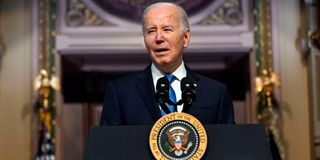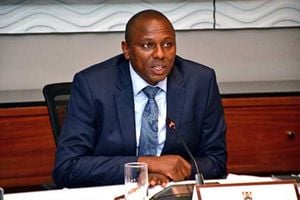Gender gap: How climate tech revolution is leaving women behind

When AV Bourke shows up at her job site, she’s one of only two women on the ground — out of about 15 workers installing solar panels. Bourke is a SolarCorps Construction Fellow at GRID Alternatives. (Courtesy GRID Alternatives)
What you need to know:
- Anna Bautista's experience working in the construction industry has seen her witness women assigned menial tasks such as cleaning, getting lunch, or organising materials rather than learning new skills of the trade.
- She has noticed micro-aggressions like when partners assume a male colleague is the boss of the job.
- An analysis of data by The Fuller Project in collaboration with Revelio Labs finds the people who hold clean energy jobs in sectors such as solar and wind, tend to be overwhelmingly male.
Anna Bautista has heard the stories working in construction: penises and breasts drawn on port-a-potty walls, sexist graffiti scrawled on job sites; photo calendars on break room walls featuring scantily-clad women. She’s seen women assigned menial tasks such as cleaning, getting lunch, or organising materials rather than learning new skills of the trade.
This treatment is not limited to old line construction sites. Bautista, the vice president of Construction for GRID Alternatives, the US’s largest non-profit solar installer, says these problems are also common in the rapidly growing green economy — to the point that she goes to great lengths to present herself as very masculine when on a job site. She’s even worn a wedding ring to a solar job site — despite not being married — so there would be no questions about what she was doing there. “I was not there to date,” she says.
One of a small group of women working in clean tech, Bautista continues to notice micro-aggressions like when partners assume a male colleague is the boss of the job, and shake his hand before hers. Or when someone refers to her as “Mr” in emails.
“It can feel like death by a thousand cuts,” she says.
Her experiences illustrate a difficult truth for President Joe Biden, who has framed clean energy as a win-win for the US economy and environment. “When I think of climate, I think of jobs,” Biden told reporters in Palo Alto, California in June, referring to $370 billion in clean energy funding in the Inflation Reduction Act, which Biden called the “most significant climate investment law anymore in the world.”

US President Joe Biden speaks at a meeting of the National Infrastructure Advisory Council, in Washington, DC, on December 13, 2023. He has framed clean energy as a win-win for the US economy and environment, relating it to creation of jobs.
A new analysis of data by The Fuller Project in collaboration with Revelio Labs, a company that uses artificial intelligence to analyse employment data, finds the people who hold clean energy jobs in sectors such as solar and wind, tend to be overwhelmingly male.
Women make up just 31 per cent of workers in green energy, the analysis found, a level largely unchanged since Barack Obama promised to create five million green jobs in 2008. The analysis found women are under-represented at both junior and senior levels of alternative energy companies, mirroring the lack of representation of women in fossil fuel companies.
Revelio reached these conclusions by collecting data from millions of online public profiles, resumes, job postings, sentiment reviews, and layoff notices, analysing them using proprietary algorithms.
The Inflation Reduction Act (IRA) and the Bipartisan Infrastructure Law (BIL), both signed during Biden’s first two years in office, do require applicants for federal grants and loan guarantees to present Community Benefits Plans, which spell out the efforts grantees will make to promote diversity and accessibility. But there are no required targets. The only goal for women’s inclusion in energy projects is a 45-year-old executive order that recommends, but does not require, that 6.9 per cent of work hours be completed by women on federally funded construction projects.
“We have quite a gap to close,” says Amanda Finney, the deputy director of public affairs for the Department of Energy.
Finney tells The Fuller Project the Biden administration is aware of the gender gap, and is looking to lead by example in closing it. The department is the largest funder of clean energy technology in the country, she says, and is screening applicants based on “specific commitments to recruiting and reducing barriers for underrepresented workers, including women.” The Community Benefits Plan required by the IRA and BIL accounts for 20 per cent of the score the agency uses to determine which projects get funded, she said.
Advocates have been warning about this trend for years. In 2010, after Obama promised a green jobs revolution, researchers at the Urban Institute noted that “the projected growth of green jobs is concentrated in overwhelmingly male dominated industries and occupations,” such as natural resources, construction, and maintenance. Two years earlier, feminist author Linda Hirshman noted in a New York Times op-ed that “it turns out that green jobs are almost entirely male.”
The solar industry is likewise conscious of the disparities. A report from Solar Industry International, a trade group, notes that “women of colour in the solar industry report that they often have to prove their competence, and they face challenges connecting with those in charge of hiring decisions.” The group says it offers specialized training and scholarships to women designed to close the gap.
At the nation’s largest solar tech company, NextEra Energy, only 24 per cent of the 15,000-strong workforce is female. The company did not return requests for comment.
“These are traditionally male-dominated jobs, and so they’re subject to the same forces as the rest of the economy that make it hard for women to enter,” says Carol Zabin, a labour economist at the UC Berkeley Labour Centre who has studied the solar industry.
Zabin notes that the best way to solve the problem is through apprenticeships — because they are structured to train people on the job and support them. Bautista agrees: having structured training both for apprenticeships as well as retention strategy, makes it more likely that everyone has equitable access to opportunities, not just those who have the best relationships on the job.
When Bautista went to MIT, her engineering track was already half women, and her first solar training was taught by two women electricians.
“I have been able to experience the things that kind of work in terms of women-only support spaces, mentors, sponsors, seeing pushes for equity,” she said.
Historically, Bautista’s experience is the exception rather than the rule. A 2017 report by the Berkeley Labour Centre found that women made up only 2-6 per cent of ironworker, electrician, and operator apprenticeships for renewable energy plants.
When AV Bourke shows up at her job site, she’s one of only two women on the ground — out of 15 or so construction workers installing solar panels. Bourke is a SolarCorps Construction Fellow at GRID Alternatives, part of an 11-month training program that aims to diversify the solar industry by helping its participants secure full-time employment once the fellowship ends. Last year, she represented them in a competition called the Solar Games where she was part of the first all-women and non-binary crew in the competition.
The job has been hard, but worth it. “It’s a lot to learn, but it helps that I’m good with my hands,” Bourke says.
When The Fuller Project requested a comment on the lack of women in the renewable energy workforce, the Department of Energy pointed to a page providing information on registered apprenticeships for women in the field, noting that they are “vastly under-represented”.
Back at her job site, Bourke says every day is a learning experience, and she’s loving the solar industry so far — despite the gender disparity. For others coming up in the field, she has a piece of advice: “If you are a newcomer, especially being a woman, it’s important to just go for it. You won’t know how good you are at something until you try.”
This story was first published by The Guardian and The Fuller Project




